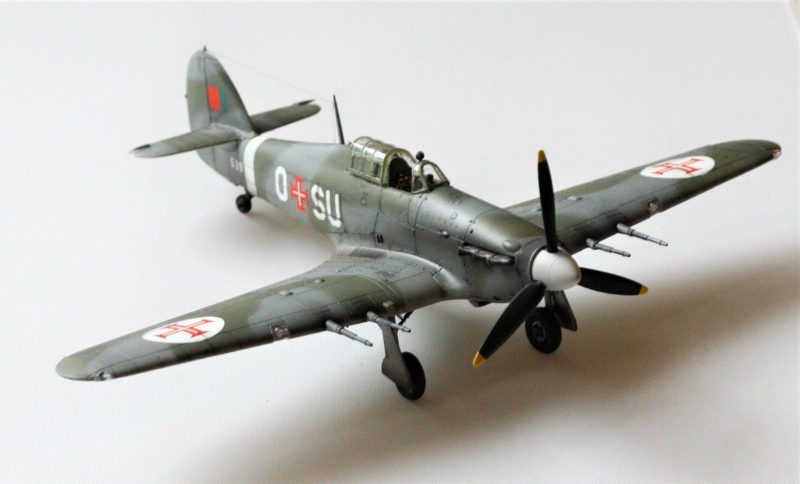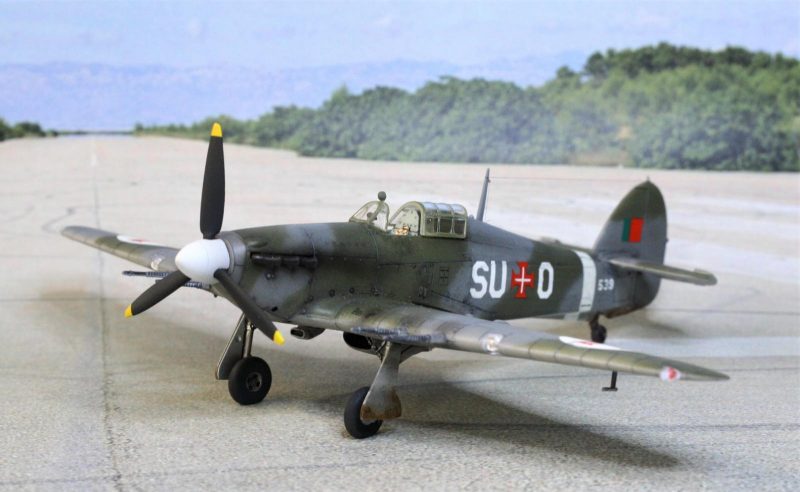The Hawker Hurricane in Portuguese service; Arma Hobby, 1:72
This article is part of a series:
the Hawker Hurricane in Portuguese service
The first six Portuguese Hawker Hurricane, of the Mk IIc model, came from British bases in Libya and flew to Portugal making a stopover in Gibraltar, where they exchanged British identification for rudimentary Portuguese crosses.
They landed at Air Base No. 2 (BA2), Ota, on 7 August 1943 in a transport operation to which the RAF gave the code name “Mildew”.
The immediate mission of these aircraft was the adaptation of the Portuguese pilots to this fighter plane, made by the British pilots who flew them from Libya, with these six planes forming the first Portuguese Hurricane squadron, identified as VX.
Between August 26, 1943 and March 1944, the remaining 97 Hawker Hurricane, essentially Mk IIb and Mk IIc models, arrived in Portugal by sea and were distributed over five squadrons (including the VX), each composed of airplanes of the same version.
The Hurricane squadrons formed were as follows:
- VX squadron, placed in BA2, with 21 Hurricane Mk IIc,
- GL squadron, placed in BA2, with 18 Hurricane Mk IIc;
- SU squadron, placed in BA2, with 21 Hurricane Mk IIc;
- TY squadron, placed in BA2, with 15 Hurricane Mk IIb;
- RV squadron, placed on BA1, equipped with Mk IIb planes and some Mk Xb, Mk XIb and Mk XIIb of Canadian origin, converted into Mk IIb, in a total of 22 planes.
Between April and September 1947 another 44 Hawker Hurricane Mk IIc and 1 Mk IIb were received, distributed among the existing squadrons.
Between 1949 and 1952 many Hurricanes were taken out of service because they were reaching the operational limit.
Meanwhile, the RV and VX Squadrons are extinguished, and their planes are distributed among the squadrons stationed at BA1 and BA3.
With such a high quantity of Hawker Hurricane, to which were added a hundred Supermarine Spitfire, Portugal had in the second half of the forties an impressive air power, with updated planes, a fact that has not been repeated, at least with the same size.
As for the painting scheme, they always maintained the camouflage of the RAF day fighters, with the upper surfaces in dark green and dark gray and the lower surfaces in light gray. They sported the Cross of Christ on a white circle on both sides of the wings.
On the sides of the fuselage, they had the Cross of Christ, without the white circle, flanked by the squadron letters painted in white and also the registration number, near the horizontal stabilizer, also in white.
On the sides of the vertical stabilizer there was a rectangle with the national colours, without the shield. The leading edges of the wings, between the landing lights and the ends of the wings, were sometimes painted in yellow, in a narrow strip. However, it is rare to find photographs with this scheme applied, the most common being the absence of this yellow stripe.
The painting was completed with the colours of the squadrons, visible in the propeller hub and in a strip around the fuselage, close to the tail. The GL Squadron used blue, RV yellow, SU white, TY red and VX green. The MP, which also used the colour green, had a white spiral in the propeller hub.
Some of these squadrons painted their badges on the left engine panel.
Hurricane's last flight was made by 615 on June 5, 1954, at Air Base No. 1.
The Kit
Commander Peixoto Rodrigues (see my previous articles on the UH-19 and SB-17G in Portuguese service) flew several Hurricane, including this SU-O, so I had to build this model.
When looking for a quality 1:72 Hurricane IIc, I found the "Arma Hobby" kits, full of detail and quality.
The kit is presented in a box that allows you to make a couple of versions, with an alternative to open or closed canopy and, depending on the "Expert" or "Standard" edition with or without photo-etched parts for the interior of the cockpit and some masks. In the standard edition the seat belts are from decals and the masks are done by yourself using the templates from the instruction sheet.
The plastic is very good, the detail is crisp, and the engineering of the kit is also good. However, some pieces are connected to the sprue in a less convenient place and could be an inch to the side without compromising the mould, making it easier for the modeler.
The decals also look very good, although I only used common stencils because the national marks were either painted or from another set.
Building and painting
The building of this kit is quite straightforward and very pleasant, and throughout the painting I found a lot of detail in the model, more common in 1:48 than in 1:72.
Not everything is perfect as said before, but not a problem.
The build started by the cockpit, which is quite nice and detailed with no major problems.
After assembling the fuselage, wings, stabilizers, and so on, I masked the canopy (used the closed one for painting) and proceed for the funny part (painting :-D).
As the kit has so much detail and does not need any filler, I just cleaned it with some IPA and skipped primer (as usual). The painting was, as I usually do, with Mr. Hobby over some pre-shading.
Following my habit of starting by the lighter colour, I painted the wheel wells and then the lighter gray on the rest of the underside.
On top, after applying the camouflage colours, I went on painting the white roundels base to the Christ Crosses on both side of the wings as well as the band on the fuselage near the tail.
Having the paint job done, it was time for the first layer of gloss coat to support the decals, followed by another one to seal them.
Painting and decaling was complemented with panel liner and some oils. A small amount of dust and some chipping was also applied, especially in the wheels and around the cockpit.
I tried to reproduce the level of weathering as seen in the photographs of the time, i.e., quite low.
After all the major painting, it was time to fix the propeller, wheels, guns, antenna wire and apply some matt coat.
Due to the pandemic times we are living, I run out of my usual matt clear (Mr Hobby) so had to use Hataka (orange line).
Last, and to conclude, was time to fix the other canopy (the open one), navigation, position and head lights. I painted their location beforehand in silver and gave a touch of colour for the navigation ones. Headlights received a touch of silver from inside the clear part to simulate the lamp.
Some of them as the one on the tail had to be done with a tiny drop of PVA glue.
And that's it!
Well, no…
Looking at some photos I noticed that the model doesn't had the rear-view mirror, so I scratched one
It was a quick and enjoyable build, hope you like it.
Cheers,
Manuel






















Maravilhoso!
Thank you for the valuable info about portougese Hurricanes and for the hints on how to build a good model of one of them.
However you have not mentioned where are the decals from. Or have you printed them by yourself?
Hi Peter, @pjotri69
Thank you for your kind words.
Yes, I missed that, sorry. I started to print some by myself (all the none white) and was going to use the letters from a british set (as the font is the same) but, at the last minute, a friend offered me a Portuguese set, already off the market.
After that I discovered another ones (not the ones I used) in a portuguese shop here's their contact: http://www.linhasdetorres-hobby.pt/ or
here's their contact: http://www.linhasdetorres-hobby.pt/ or
linhasdetorres.hobby@gmail.com
All the best,
M
Really nice, Manuel! Those Arma Hurricanes are Da Bomb. You got the maximum from the kit.
Hi Tom!
Thank you for your kind words!
Yes, the kit is great, can't wait for the 1:48 one
Great airbrush work, Manuel! Very well done in 1/72.
Thank you for your kind comments, much appreciated
Thanks for sharing this great information, Manuel.
The build is fantastic, especially since this is 1/72.
The pictures do make it look like real.
Thank you John, my pleasure!
Your nice words are much appreciate
Another beauty Manuel! 1/72 is not my scale but your hurricane could pass for a bigger scale at first sight.
Muito bom trabalho sem dúvida! Parece que está empresa irá lançar este modelo á escala 1/48, e mantendo a qualidade evidência da no seu modelo, será certamente um sucesso...eu pelo menos compro 1
Tenho algumas folhas de decalques com a cruz de Cristo mas a 1/48. Se algum dia precisar avise
Hi @holzhamer
Thank you for your kind words!
Sim, a Arma Hobby tem um Hurricane a 1:48 anunciado para este ano mas ainda sem qualquer data. Tb comprarei pelo menos um
Também estou (como se pode ver pelo que fiz ultimamente) a ficar fã de 1:48, não só pelo detalhe como por contingências oftalmologicas
Habitualmente pinto as rodelas brancas e imprimo as cruzes, o meu problema é mais com as letras brancas. Agradeço a oferta e retribuo: se precisar de alguma coisa impressa que eu possa ajudar, disponha.
Um abraço
Looks great in this scheme!
thanks Rob! @roofrat
although very similar to the British scheme, Portuguese marks give her another charm
Good write-up, nicely finished model and great photographs, what more could we ask for? Definitely liked.
Wow! Thanks a lot for the great comments George, you're too kind, much appreciated.
Greetings from Portugal
This is a wonderful build, Manuel @magrus!
Surely fools the scale, as it may well pass for an excellently built quarterscale Hurricane.
I have to say that I love all these current well detailed 1/72 super kits, lile this one: surely 1/72 deserves such good representations. Don't get me wrong: I love 1/48 scale (indeed, I love all scales!).
Very nice historical and buld sequence supporting text, too!
Thanks Spiros @fiveten!
You are a great friend, always with warm words and compliments. Truly appreciated here.
In fact, the kit is really good so you don't have much trouble getting an average result as mine.
Best wishes from Portugal, stay safe
What a beautiful Hurricane! Love the paint work, and the markings really set it off. I may have to snag one of these Arma Hobby kits!
Thanks Greg!
Yes, you should try one of these kits. Or wait for the 1:48.
Or get both... ? Eheheh